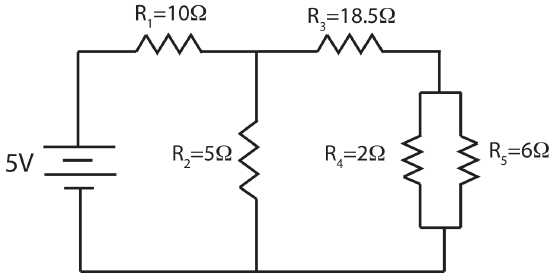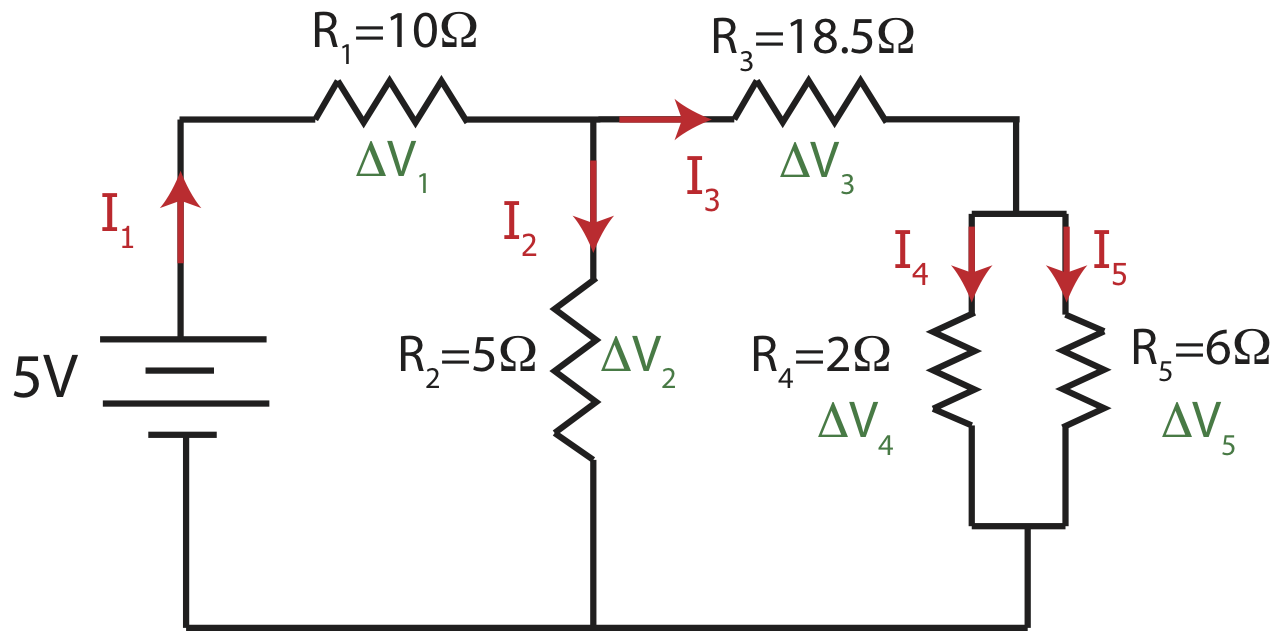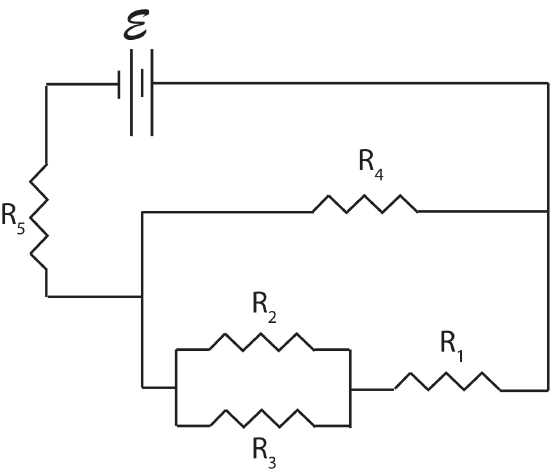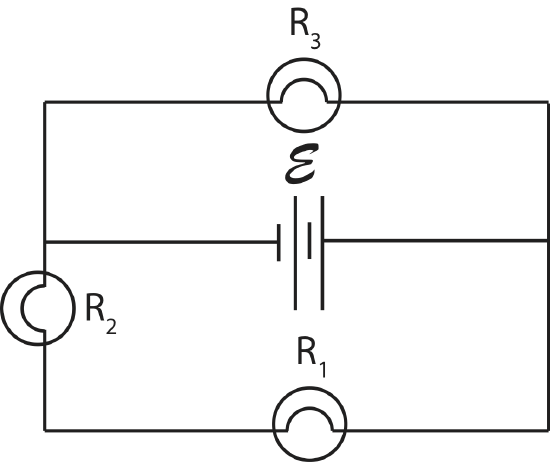5.6: Circuit Problem Solving
( \newcommand{\kernel}{\mathrm{null}\,}\)
Solving Electric Circuit Problems
When tackling a circuit problem you may need to figure out the equivalent resistance of the circuit, voltage drops across resistors, total current coming out of the battery or current through specific resistors, power dissipated by resistors or provided by the battery, relative brightness of light bulbs in a circuit, the effect of a shorted resistor, or a burnt one, and more.
Below are a few useful steps to follow. Even though these basics steps are provided, it is never a good idea to follow a procedure verbatim. This procedure is a good starting guide of tacking some circuit problems, but might not apply to all of them in the order provided. As you start working with more advanced scenarios, think of ways of how you can work backwards, follow the steps in different order, or only use some of the steps to solve your particular problem most efficiently.
Circuit problem solving procedure:
1) Calculate the equivalent resistance of the circuit. First combine all the series resistors and then calculate the parallel ones. Use the following equations:
series: Req=n∑iRi
parallel: 1Req=n∑i1Ri
2) Use your result of equivalent resistance to find the total current coming out of the battery:
Itot=EReq
3) Apply the loop rule to all the loops present in the circuit in order to find the relationship between voltage drops and emf of battery. Make sure you are consistent with the direction of the loop you choose. If your loop takes you from a negative to the positive terminal of the battery, you will get, +E. If you loop takes you across a resistor in the direction of the current, then the correct sign of the voltage difference should be negative, ΔV=−IR. In general for any given loop, the following must be true:
∑E+∑ΔV=0
4) Apply the junction rule at all the junctions to find the relationship between the current going into the junction and the individual currents in each of n paths:
Iin=n∑iIi
Example 5.6.1
For the circuit show below find the current and voltage for each of the five resistors.

- Solution
-
It is a good idea to start by labeling all the currents and voltage as shown below.

Since all the resistances are known, the first natural step is to find the equivalent resistance. For this particular circuit the best way to combine resistors is: resistors 4 and 5 are in parallel, their combination R45 is in series with R3. The combination of 3,4, and 5, R345 is in parallel with 2, and their combination, R2345 is in series with R1.
First, calculating R4 and R5 in parallel:
1R45=1R4+1R5=12Ω+16Ω=23Ω
R45=32Ω
Combining R3 in series with R45:
R345=R3+R45=18.5Ω+1.5Ω=20Ω
Combining R3 in parallel with R345:
1R2345=1R2+1R345=15Ω+120Ω=14Ω
R2345=4Ω
And finally combining R1 in series with R2345 to find the equivalent resistance of this circuit:
Req=R1+R2345=10Ω+4Ω=14Ω
Resistor 1 is the only resistors which is in series with the battery, so the current through resistor 1, I1, will be equal to the total current coming out of the battery:
I1=Itot=EReq=5V14Ω=0.357A
Once we know the current through 1, we can find the voltage across resistor 1:
ΔV1=−I1R1=0.357A×10Ω=−3.57V
Now we can apply the loop rule to the first loop on the left that goes through the battery, resistor 1, and resistor 2 to find the voltage across resistor 2:
E+ΔV1+ΔV2=0
ΔV2=−E−ΔV1=−5V+3.57V=−1.43V
Since we know the voltage across resistors 2, we can figure out the current through that resistor, I2:
I2=−ΔV2R2=1.43V5Ω=0.286A
Next, we can use the junction rule to find the amount of current that goes to the other branch and through resistors 3, I3:
I1=I2+I3
I3=I1−I2=0.357A−0.286A=0.071A
Knowing the current, allows us to find the voltage drop across R3:
ΔV3=−I3R3=−0.071A×18.5Ω=−1.3135V
Applying the loop rule to the outermost loop we can find the voltage drop across the parallel combination of R4 and R5:
E+ΔV1+ΔV3+ΔV45=0
ΔV45=−E−ΔV1−ΔV3=−5V+3.57V+1.3135V=−0.1165V
Lastly, since we know the voltage drop across the parallel set of 4 and 5, it must equal to the voltage drops across each one of the resistors, ΔV45=ΔV4=ΔV5. Using this, we can find the currents I4 and I5:
I4=−ΔV4R4=0.1165V2Ω=0.0583A
I4=−ΔV5R5=0.1165V6Ω=0.0194A
Example 5.6.2
While playing with electronics in class you build a circuit with one battery and five resistors. You calculate the following equivalent resistance:
Req=[1R1+(1R2+1R3)−1+1R4]−1+R5
a) Draw a possible circuit connected to a battery that has the above equivalent resistance. Clearly mark each resistor with R1, R2, R3, R4, and R5.
b) Assume that Req=25Ω, R4=R1+(1R2+1R3)−1, and R2=2R3. If the circuit is connected to a 10V battery, how much current will flow through R2?
c) If R2 was shorted out, what would be the new equivalent resistance in terms of the resistor numbers? Would the total current coming out of the battery increase, decrease, or stay the same?
- Solution
-
a) The equation above states that R5 is in series with a parallel branch which contains R4 in one path and R1+(1R2+1R3)−1 in the other. The other path has R1 in series with a parallel branch containing R2 and R3 as shown.

b) The total current coming out of the battery is
I=EReq=10V25Ω=0.4A
The two paths of the main parallel branch have equal resistance, so the current will split equally at the junction. This means that half the total current will flow through R1, which is 0.2A. The current will split further between R2 and R3. Since R2=2R3, R3 will get double the current of R2 since their voltage drops have to be the same.
ΔV2=ΔV3
I2R3=I3R3
I2=I32
Using the fact that I2+I3=0.2A and the above result we get:
I2=I32=0.2−I22
Resulting in I2=115A.
c) If R2 was shorted out, all the current going through R1 would go though the wire, so R2 and R3 would not get any current and are no longer part of the active circuit. The new equivalent resistance becomes:
Req=R5+(1R4+1R1)−1
Since the lower branch now has reduced resistance, the combined resistance between R4 and the lower branch will decrease, thus the total equivalent resistance of the entire circuit will be decreased. Smaller total resistance means that the total current will increase since, I=EReq.
Example 5.6.3
You build the circuit shown here and find that the brightness of light bulb 1 twice as bright (double power) as 3, and the brightness of light bulb 1 is half as bright as 2 (half power).

a) You know that light bulb 3 has resistance of 36Ω. Find the resistance of light bulbs 1 and 2.
b) You add a wire across light bulb 1. Describe what happens to the brightness of each light bulb (gets brighter, gets dimmer, stays the same brightness, or is not lit) compared to the original circuit.
c) If light bulb 1 in the original circuit burnt out instead, what happens to the brightness of each light bulb (gets brighter, gets dimmer, stays the same brightness, or is not lit) compared to the original circuit?
- Solution
-
a) Resistors R1 and R2 have the same current since they are in series, I1=I2. Since P=I2R and P2=2P1 we conclude that:
P2=I2R2=2P1=2I2R1
R2=2R1
When it comes to resistors in parallel, it is often simpler to think in terms of voltage drops rather than current. The voltage drop across R3 has to equal to the voltage drop across the other branch which includes the sum of voltage drop across R1 and R2:
ΔV3=ΔV1+ΔV2
Since R2=2R1 and ΔV=−IR, ΔV2=2ΔV1, and the above equation becomes:
ΔV3=3ΔV1
We also know that P1=2P3. Using P=ΔV2R we find that:
ΔV21R1=2ΔV23R3
Using the result ΔV3=3ΔV1 we find that:
ΔV21R1=18ΔV21R3
R3=18R1
Using R3=36Ω, we find that R1=2Ω, and using R2=2R1, we find that R2=4Ω.
b) Adding a wire across R1 shorts out R1, since all the current will go through the wire. So R1 will not be lit. The voltage drop across R2 has to increase, since due to the loop rule applied to the bottom loop, all the voltage now drops across rather R2, E=−ΔV2, rather than being split between R1 and R2 in the original circuit. Since power is proportional to voltage drop, 2 gets brighter. The voltage drop across R3 doesn’t change due to loop rule for top loop, E=−ΔV3, so 3 stays the same brightness.
c) If light bulb 1 burns out, the path on the lower loop is broken (there is no place for current to go), so both R1 and R2 will not be lit. The voltage drop across R3 doesn’t change due to loop rule for top loop as in the argument for b), so 3 stays the same brightness.


